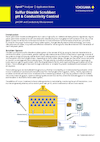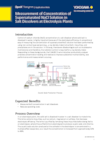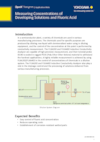How Is Inductive Conductivity Measured?
Toroidal conductivity measurements from toroidal conductivity sensors (also called inductive sensors) are used in applications susceptible to high fouling/coating, metal corrosion, high conductivity, and percent concentration due to the fact that their sensing elements (electrode coils) don’t come into direct contact with the process. These two matched (identical) coils are encapsulated in PEEK (or Teflon) protecting them from the adverse effects of the process, making them suitable for the following applications:
- High conductivity
- Fouling /coating (dirty applications)
- Percent concentration (e.g. brine, cleaning solutions)
- Processes susceptible to metal corrosion
Toroidal Conductivity
Yokogawa’s ISC40 toroidal conductivity sensor has only one cell factor (constant) and covers nearly the entire conductivity measurement range: ~50-2,000,000 µS/cm. With proper installation, the ISC40 is virtually maintenance free.
 How Do Toroidal Conductivity Sensors Work?
How Do Toroidal Conductivity Sensors Work?
Two matched coils (electrode coils) are encapsulated with PEEK or PFA material, protecting them from the adverse effects of the process. These coils are the sensing elements of an inductive sensor. They do not come in direct contact with the process.
The driver coil generates a magnetic field, which is carried through the liquid that flows through the donut hole of the sensor to the receiving coil. The differential between the two coils is the conductivity of the solution.
Details
Accuracy in Fouling, Coating, and Corrosion
The ISC40 has an accuracy of 0.5% of reading plus 0.5 µS/cm for any conductivity value (whether measured in rinse water or in concentrated acids).
The sensors have a large bore for optimal resistance to fouling processes, providing long term stability, and with proper installation, the flow will keep the sensor clean, preventing measuring errors.
Long Life Under Harsh Industrial Conditions
Constructed with erosion and abrasion-resistant PEEK (Poly Ether Ether Ketone), the ISC40 has excellent chemical resistance in all solutions with the exceptions of fluoric acid or oxidizing concentrated acids. For stronger chemical resistance, PFA (Teflon) material is available for applications in hydrofluoric acid and oxidizing concentrated acids (e.g. nitric, sulfuric, oleum).
Rugged Design and Installation Flexibility
The ISC40 sensor has a rugged stainless steel mounting thread and nut and gasket combination for ultimate flexibility in installation using a bulkhead installation technique. A wide range of holders and options are also available for reliable in-line or off-line installation, and double O-ring seals provide the sensor with long service life.
Additional models are available for use in ball-valve insertion applications and in sanitary flange installations.
Percent Concentration
There are numerous industrial applications where measurements and/or control of a specific chemical strength of the process is critical for optimizing the production of the end product. These specific concentrations are obtained by mixing a full strength solution with water to achieve the desired percent concentration. Conductivity measurement is a reliable indicator of the concentration of most acid or base solutions.
Brine Manufacturing
Brine is often used within industrial processes such as food and beverage, refineries, textile dyeing house, and chemical plants as well as in municipalities or for commercial use as a final product applied to pavement roadways or commercial parking lots as an anti-icing or de-icing agent.
Conductivity measurement can be used as a reliable indicator of the real-time brine concentration. Utilizing online process analyzers removes the need for timely grab sample analysis. Yokogawa’s inductive conductivity analyzers help you achieve increased efficiency and reduced operating costs while realizing reliable brine concentration measurements.

Measuring Electric Conductivity with Clean-in-Place (CIP) System
In the Pharmaceutical, Chemical and Food & Beverage industries, after manufacturing products, the cleaning and sterilization of tanks and piping are done with various cleaning solutions, fresh or hot water and steam. Clean-in-Place (CIP) is a system designed for automatic cleaning and disinfecting.
Yokogawa’s inductive conductivity liquid process analyzer takes measurements with good boundary surface precision over a wide range, earning it a reputation in the recovery of cleaning, which contributes significantly to reduce chemical and wastewater processing costs.
Depending on the region there are different versions of the holders available.
ISC40FF/ISC40FS/ISC40FD Holders
This program includes flow fittings and their subassemblies for in-line or direct mounting of conductivity sensors in piping systems. A wide choice of construction materials gives the user the best solution for any process considering chemical resistance, pressure and temperature specifications.
- Wide choice of construction materials.
- High degree of standardization to all cells.
- Easy mounting, service and removal or replacement of sensors.
- Electrolitically polished stainless steel designs for optimal corrosion resistance.
- Available with flange adapters.
Model PR10 Retractable "Hot-Tap" Holder
On-line measurements often present extra challenges, especially when routine maintenance is required. The PR10 is ideally suitable for applications where the sensors must be removed without interrupting or shutting down the process. Without any special tools the PR10 can be retracted safely from the process at pressures up to 5 bar (72 psi). The PR10 is a universal retractable assembly that can be used for all liquid measurements. The PR10 is designed to accept any commercially available pH/ORP or dissolved oxygen sensor that has a PG13.5 connection while still being backward compatible with old Yokogawa electrodes.
For ease of use optional flush ports are available. In the retracted position the sensor can be kept moist, cleaned or even calibrated. This can all be done without process interruption or disassembly of the armature.
- One model for pH/ORP, dissolved oxygen, conductivity and inductive conductivity sensors
- All commercially available pH electrodes, such as PG13.5, SMART sensors, Vario Pin, YEF and DIN connectors can be installed in the PR10.
- Integrated protection cage
- A "scraper" is built-in to each assembly to effectively scrape or wipe off the
process from the PR10's shaft as it is being retracted from the process. - A safe "through the valve" insertion and retraction design
- Simplified installation by optional ball valves with flanged or tapered connections
- Optional flush port accessories make it easy to keep sensors moist (pH) and clean, and also provides access for calibration if desired.
Calibration Standard Solutions
Yokogawa supplies Hamilton conductivity standards whose stability of ±1% is guaranteed over a life cycle of 1 to 3 years, depending on the value.
| 238934 | 100 µS/cm Solution |
| 238985 | 147 µS/cm Solution |
| 238929 | 706 µS/cm Solution |
| 238986 | 1413 µS/cm Solution |
| 238988 | 12880 µS/cm Solution |
| 238935 | 100 mS/cm Solution |
Resources
To defray energy costs, many industrial plants have their own boilers to generate steam to produce a portion of their energy needs. In addition to generating power, the steam may also be used directly in plant processes or indirectly via heat exchangers or steam jacketed vessels.
Conductivity measurement can be used as a reliable indicator of the real-time brine concentration. Using an online process analyzer removes the need for timely grab sample analysis.
To technology in iron & steel industry is continuously improved to obtain the best possible performance. The improved plant performance gives rise to the higher quality improvement and lower cost, and simultaneously environmental friendly plant operation.
Process liquid analyzers such as pH meters, conductivity meters, ORP meters, and density meters play an important role at electrolysis plants in the control of concentrations of various process solutions. This requires both precision and stability under harsh conditions that include highly corrosive substances, high temperatures, and many impurities.
The kraft process, also known as kraft pulping or the sulfate process, is a technology for conversion of wood into wood pulp that consists of almost pure cellulose fibers. Today, the kraft process is used in approximately 80% of paper production.
Control of sodium chloride (NaCl) concentration at a salt dissolver where solid salt is dissolved in water, is highly important because of the electrolysis efficiency. A conventional way of measuring the concentration of supersaturated NaCl solution had been performed by using non-contact type sensors (e.g., γ-ray density meter) since NaCl, impurities, and precipitates are in the solution.
In a semiconductor plant, a variety of chemicals are used in various manufacturing processes. The chemicals used for specific purposes are produced by diluting raw liquid with demineralized water using in diluting equipment, and the control of the concentration at this point is performed by conductivity measurement.
Clean-in-place (CIP) is the system designed for automatic cleaning and disinfecting in the food & beverage, pharmaceutical, and chemical industries. Tanks and piping are cleaned and sterilized with various cleaning solutions, fresh or hot water, or steam after manufacturing products is completed.
There are numerous industrial applications where measurements and/or control of a specific chemical strength of the process is critical for optimizing the production of the end product. These specific concentrations are obtained by mixing a full strength solution with water to achieve the desired percent concentration.
Downloads
General Specifications
Technical Information
- Installation Guide for the ISC40G(S)-GS Sensor with a Sanitary Fitting (508 KB)
- ISC40 Flange Adapters Dimensions & O-Rings (164.9 KB)
- ISC40 Local Immersion Adapters (152.7 KB)
- ISC40*-TG Installation in Local Tee (907 KB)
- ISC450 Calibration In Place (89 KB)
- ISC450 Programming Custom Curves (130 KB)
- Programming Percent Concentration Curves in ISC450 (103 KB)
Certificates
- Declaration of Victrex FDA PEEK (162 KB)
- EU_UK Declaration of Conformity ISC40G_ISC40S 2022-10-03 (202.1 KB)
- FLXA21 with ISC40S RINA type approval ELE482021CS/001 (620.9 KB)
- ATEX ISC40 11ATEX0063X-Issue 1
- ISC40 Teflon Material Datasheet (114 KB)
- IECEx for ISC40 DEK 11.0028X-Issue 0
- FM certificate of conformity FM21US0083X (328.4 KB)
- CAN/CSA certificate of confirmity FM22CA0012X (309.3 KB)
- ISC40S ATEX/ IECEx (1.3 MB)
- IECEx for ISC40 DEK 11.0028X-Issue 1 (486.1 KB)
- EAC certificate for sensors (1.8 MB)
- ISC40S FM (57 KB)
- ATEX ISC40 11ATEX0063X Issue 2 (2.3 MB)
- Mercury Free Declaration (101 KB)
Engineering Tools
- ISC40X-G-T1-05/SCT2 INDUCTIVE CONDUCTIVITY SENSOR (79 KB)
- Inductive Conductivity Sensor ISC40#J (291 KB)
- Flow-Through Type Holder ISC40FFJ-P#,ISC40FFJ-F# (35 KB)
- Inductive Conductivity System Flow-through Type Holder with Flange ISC40FFJ-P#/F##,ISC40FFJ-F#/F## (38 KB)
- Flow-Through Type Holder ISC40FFJ-SJ/FSJ2,ISC40FFJ-SA/FS2 (39 KB)
- Flow-Through Type Holder ISC40FFJ-S# (37 KB)
- Inductive Conductivity System Immersion Type Holder ISC40FDJ (67 KB)
- Direct Insertion Adapter IDF 3 inch Clamp ISC40FSJ-STWJ (28 KB)
- Inductive Conductivity Metering System Sensor Adapter (Welded type) ISC40FSJ-SCWJ (30 KB)
- Sensor Adapter (Screw-in type) ISC40FSJ-SCSJ,ISC40FSJ-PCSJ,ISC40FSJ-FCSJ (30 KB)
MSDS/SDS
- 238929 - 706 µS/cm Conductivity Standard Solution (109 KB)
- 238934 - 100 µS/cm Conductivity Standard Solution (109 KB)
- 238935 - 100 mS/cm Conductivity Standard Solution (109 KB)
- 238985 - 147 µS/cm Conductivity Standard Solution (107 KB)
- 238986 - 1413 µS/cm Conductivity Standard Solution (107 KB)
- 238988 - 12880 µS/cm Conductivity Standard Solution (107 KB)
Videos
Installing the sanitary fitting on an ISC40 sensor. While we strive to provide the most safe and accurate information possible, we are not responsible for any loss or damages resulting from attempting to replicate the acts conducted in this video. Furthermore, we shall not be held liable for use or misuse of information contained in this video.
Looking for more information on our people, technology and solutions?
Contact Us











